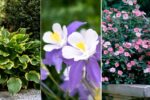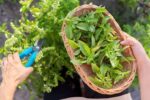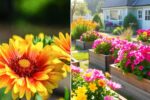Join on WhatsApp
Get the latest updates directly on WhatsApp – motivation, news & more!
Bees and butterflies are more than just charming visitors to your garden they’re vital pollinators that help plants reproduce, increase biodiversity, and keep ecosystems healthy. Unfortunately, both are facing rapid population declines due to habitat loss, pesticides, and climate change. The good news? Your garden, no matter how big or small, can be part of the solution.
With a few intentional choices, you can transform your outdoor space into a haven for these essential pollinators. It doesn’t require a complete garden overhaul just simple, thoughtful steps that provide food, shelter, and safety. Here’s how you can make a big difference, one plant at a time.
Choose Native Plants Whenever Possible
Native plants are the backbone of a pollinator-friendly garden. They’ve evolved alongside local bee and butterfly species, providing the nectar, pollen, and leaf types they rely on. Native plants are also well adapted to your climate and soil, meaning they often require less water and maintenance.
When selecting native plants, aim for a variety of species that bloom at different times of the year. This ensures a steady supply of nectar and pollen from early spring to late fall. A mix of wildflowers, grasses, shrubs, and even native trees can create a layered and inviting habitat.
Plant in Clumps and Layers
Bees and butterflies are more likely to visit your garden when they can find flowers grouped together. Instead of scattering single plants across your yard, plant in clusters of the same species. This makes it easier for pollinators to locate and access their favorite flowers.
Varying the height and structure of your plants also creates a more dynamic environment. Tall sunflowers and milkweed can stand behind mounds of lavender, while creeping thyme fills in the ground. These layers not only attract different pollinators but also provide shelter and resting spots.
Grow Plants With Single Blooms
Many modern garden flowers have been bred for appearance, often producing double or ruffled blooms. While these may look pretty to us, they can be difficult or impossible for pollinators to access. Single-bloom flowers, on the other hand, keep their nectar and pollen exposed and easy to reach.
Old-fashioned varieties of zinnias, cosmos, coneflowers, and daisies are excellent choices. Their open shapes make them irresistible to bees and butterflies alike, and their extended bloom times offer food well into the growing season.
Avoid Pesticides and Herbicides
Even small amounts of chemical pesticides and herbicides can be harmful to bees, butterflies, and other beneficial insects. These substances don’t just kill pests they can linger in the soil, coat plant surfaces, and contaminate water sources.
Instead of reaching for chemicals, try natural alternatives for pest control. Companion planting, introducing beneficial insects like ladybugs, and using neem oil or insecticidal soap are safer options. Creating a diverse garden with healthy soil also reduces the likelihood of infestations in the first place.
Provide a Water Source
Just like people, pollinators need water to survive. Bees and butterflies drink from shallow sources like puddles, damp soil, or the edges of birdbaths. Adding a simple water station to your garden can be a life-saver especially during dry, hot spells.
Use a shallow dish filled with pebbles or stones and water. The stones give insects a place to land and rest while they drink. Be sure to clean and refill the water regularly to keep it fresh and safe.
Let a Few Weeds Bloom
Not every plant in your garden has to be manicured or intentional. Many so-called “weeds” like clover, dandelions, and plantain provide vital early-season nectar and pollen when little else is blooming.
Consider leaving a patch of your lawn or garden a little wild. These areas can offer unexpected food sources and shelter. Of course, it’s always important to balance this with your local ecosystem some invasive weeds can do more harm than good, so learn what’s native to your region.
Create Shelter and Nesting Spots
Pollinators need more than food and water they need safe places to rest, hide, and raise their young. Butterflies often lay eggs on host plants like milkweed or fennel, while many native bees nest in hollow stems, leaf litter, or bare ground.
Avoid over-mulching your garden and leave a few areas undisturbed. Installing a bee hotel or simply letting some dead wood or tall grass remain can also provide vital nesting sites. Butterflies benefit from shrubs and trees that shield them from wind and weather.
Include Night-Blooming and Fragrant Plants
While many bees are active during the day, some pollinators like moths and certain butterfly species prefer the evening hours. Including night-blooming plants such as evening primrose, moonflower, or night phlox ensures your garden supports a broader range of species.
Fragrant plants can also attract pollinators from farther away. Scents like lavender, bee balm, or sweet alyssum are not only pleasant for humans but also help guide bees and butterflies to your garden.
Limit Lawn Space
Traditional lawns offer little value to pollinators. They’re often heavily treated with chemicals, provide no food, and require frequent mowing. Replacing even a small portion of your lawn with pollinator-friendly plants can have a significant ecological impact.
Consider planting a wildflower meadow, creating a butterfly garden, or installing a native plant border. These areas not only support bees and butterflies but also add color, texture, and movement to your yard.
Educate Others and Share Seeds
One of the most powerful things you can do is inspire others. Share your garden’s success with friends, neighbors, or local schools. Offer seeds or cuttings from your pollinator plants. The more people who create safe spaces for bees and butterflies, the greater the collective impact.
Even in urban environments, small balcony gardens, rooftop planters, or community garden plots can provide crucial habitat. Every bloom counts, and every gardener can help.
Final Thoughts
Supporting bees and butterflies isn’t just a trend it’s a responsibility we all share in protecting our natural world. By making simple, mindful changes to your garden, you can create a thriving ecosystem that gives back season after season.
Pollinators will reward your efforts with beauty, biodiversity, and a healthier planet. Whether you have a sprawling yard or a few pots on a patio, your space can become a sanctuary. Start small, stay consistent, and watch as your garden becomes a buzzing, fluttering hub of life.




